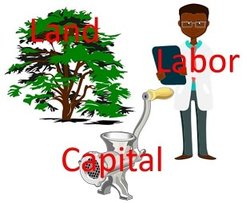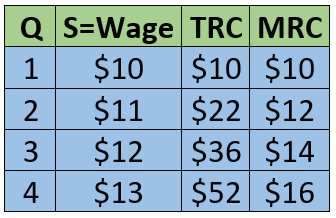Monopsony Factor Markets
Updated 9/27/2021 Jacob Reed
Factor markets are an important part of any Microeconomic Principles class. If you are preparing for an Advanced Placement (AP), IB, or college exam, reviewing these markets is essential. Below is a quick examination of the important aspects of monopsony factor markets.

Note: The examples below use labor but these concepts apply to a firm’s use of capital and land as well.
What is a monopsony?
A monopsony is a market with just one buyer. As a result, monopsonies are not wage takers like firms in perfectly competitive factor markets. Also since there is only one firm buying labor, the market is the firm (much like monopolies) and there is only one graph. The demand curve is still equal to the MRP and the firm will still hire where the MRC equals the MRP. The difference is since there is only one firm, the firm sees the entire market supply curve; which is upward sloping. Hiring more workers requires increasing the wage for all workers hired; not just the last worker hired. As a result, the cost of hiring additional workers (MRC) is higher than the wage workers are paid (the supply). For those reasons, the MRC is higher than the supply curve.
The quantity of workers hired is where MRP equals MRC, but the wage paid will be found at the supply curve below. Monopsonies hire fewer workers and pay them less (Qm and Wm) when compared to perfectly competitive labor markets (Qc and Wc).
Note: The trick to identifying a monopsony when there is a chart instead of a graph is that the wage will increase with the quantity of workers.

Why is the Marginal Resource Cost above the Supply for a Monopsony?
When a monopsony wants to hire more workers, wages must be increased to induce workers to give up their leisure. The assumption behind this introductory model is that all workers are paid the same. As a result, when wages are increased to hire one more worker, wages must be raised for all previous workers hired too. This causes the marginal cost of hiring more workers (MRC) to be higher than the supply (S=Wage). Take a look at the chart. 3 workers are paid $12 each for a total resource cost (TRC) of $36. If the firm wants to hire a 4th worker, the wage must be increased to $13. Since all 3 other workers are also paid $13, the marginal resource cost more than the wage at $16.

Up Next:
Review Game: Points, Prices, and Quantities
Graph Drawing Practice: Factor Markets and Market Failures
Content Review Page: Resource Combinations
Other recommended resources: mjmfoodie (Monopsony)
